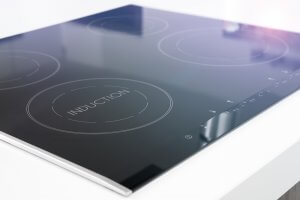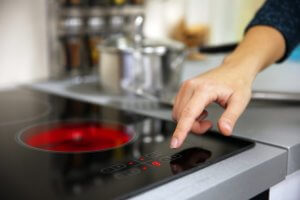Types of Vitroceramic for your Kitchen

When it comes to furnishing the kitchen, you should think about the different types of ceramic glass. You might have a lot of questions about prices, energy savings, usage mode. As you know, there are other types of stovetops. Some examples are butane gas stoves, gas stoves or electric stoves. However, the most common options are vitroceramic.
Vitroceramic is generally very easy to clean, which is a breakthrough. Also, it has indicators that will tell you when the surface is still hot after it’s been used. You can even set a timer on some of these stoves for an automatic shut off. This is great for saving energy and will reduce the risk of fire.
Types of vitroceramic: radiant
These are the traditional vitroceramic options. With these, the heat expands to everything around it. The heat is generated through a system of radiants that creates resistance. From there, the temperature increase and everything that’s placed on the plate gets heated.
You can use any type of container to cook on this surface, which is not the case with some of the other options.
Despite being somewhat outdated, they’re still the most economical option. It’s sometimes necessary to scrape the surface a bit with a special scraper to clean it.

Types of vitroceramic: induction
The induction option is becoming more and more common in homes, and it’s also the most modern type. In this case, the goal isn’t to generate heat, but to create a magnetic field that will produce energy. This is done by using coils.
Ideally, you’ll want to use containers made with ferromagnetic material that’s designed for this purpose. The containers should also have a flat, smooth and thick bottom. When they come in contact with that electromagnetic field, heat is transmitted that will quickly heat the food.
One advantage of this option is that the glass used is barely heated. This makes cleaning the plate easier and helps you avoid any risks if you have small children at home. For example, if you happen to spill a liquid on it, you can easily wipe it with a cloth and it won’t leave that burnt smell.
Also, if you get distracted and forget to turn the burner off, nothing will happen as long as there’s nothing left on top of it. And, if you put a container on the burner that’s smaller than the plate itself, the heat will adapt to its shape. This will help you avoid any loss of heat that would happen with other stovetops.
Electric ceramic cooktop
This option has an electrical resistance under the glass. The heat regulates itself automatically since a thermostat that depends on the current controls it.
They’re quite cheap and that’s their main advantage over other types. They can also come with protective mechanisms that help prevent the possibility of overheating.
Gas vitroceramic
These stovetops work thanks to butane gas, which turns on automatically. There are valves that are responsible for regulating the gas by closing off or opening up the passageway.
Try to avoid those that require matches to start them; you want one that has an electric start. In the most modern designs, there’s no need for matches. They consume little energy but aren’t the most effective option. One of their main advantages is that they’re fairly easy to clean.
You may even find some burners under the glass that have a beehive honeycomb design.
As you can see, there’s a variety of options. You just have to look at all of the pros and cons of each, look at your daily needs as well as the style of your kitchen and the rest of the house. Whether you need a more luxurious look or one that’s more rustic, the styles are endless.
In addition to these options, there are more and more innovations in cooktops. As we move away from the more traditional options, there are more automated ones coming onto the market. So, you can find smart cooking options.
When it comes to furnishing the kitchen, you should think about the different types of ceramic glass. You might have a lot of questions about prices, energy savings, usage mode. As you know, there are other types of stovetops. Some examples are butane gas stoves, gas stoves or electric stoves. However, the most common options are vitroceramic.
Vitroceramic is generally very easy to clean, which is a breakthrough. Also, it has indicators that will tell you when the surface is still hot after it’s been used. You can even set a timer on some of these stoves for an automatic shut off. This is great for saving energy and will reduce the risk of fire.
Types of vitroceramic: radiant
These are the traditional vitroceramic options. With these, the heat expands to everything around it. The heat is generated through a system of radiants that creates resistance. From there, the temperature increase and everything that’s placed on the plate gets heated.
You can use any type of container to cook on this surface, which is not the case with some of the other options.
Despite being somewhat outdated, they’re still the most economical option. It’s sometimes necessary to scrape the surface a bit with a special scraper to clean it.

Types of vitroceramic: induction
The induction option is becoming more and more common in homes, and it’s also the most modern type. In this case, the goal isn’t to generate heat, but to create a magnetic field that will produce energy. This is done by using coils.
Ideally, you’ll want to use containers made with ferromagnetic material that’s designed for this purpose. The containers should also have a flat, smooth and thick bottom. When they come in contact with that electromagnetic field, heat is transmitted that will quickly heat the food.
One advantage of this option is that the glass used is barely heated. This makes cleaning the plate easier and helps you avoid any risks if you have small children at home. For example, if you happen to spill a liquid on it, you can easily wipe it with a cloth and it won’t leave that burnt smell.
Also, if you get distracted and forget to turn the burner off, nothing will happen as long as there’s nothing left on top of it. And, if you put a container on the burner that’s smaller than the plate itself, the heat will adapt to its shape. This will help you avoid any loss of heat that would happen with other stovetops.
Electric ceramic cooktop
This option has an electrical resistance under the glass. The heat regulates itself automatically since a thermostat that depends on the current controls it.
They’re quite cheap and that’s their main advantage over other types. They can also come with protective mechanisms that help prevent the possibility of overheating.
Gas vitroceramic
These stovetops work thanks to butane gas, which turns on automatically. There are valves that are responsible for regulating the gas by closing off or opening up the passageway.
Try to avoid those that require matches to start them; you want one that has an electric start. In the most modern designs, there’s no need for matches. They consume little energy but aren’t the most effective option. One of their main advantages is that they’re fairly easy to clean.
You may even find some burners under the glass that have a beehive honeycomb design.
As you can see, there’s a variety of options. You just have to look at all of the pros and cons of each, look at your daily needs as well as the style of your kitchen and the rest of the house. Whether you need a more luxurious look or one that’s more rustic, the styles are endless.
In addition to these options, there are more and more innovations in cooktops. As we move away from the more traditional options, there are more automated ones coming onto the market. So, you can find smart cooking options.







